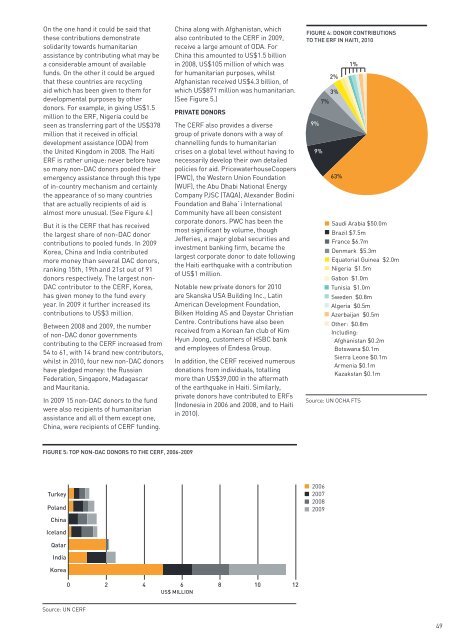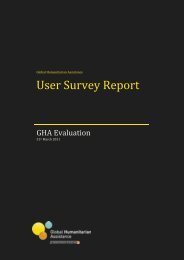GHA-Report-2010.pdf - Global Humanitarian Assistance
GHA-Report-2010.pdf - Global Humanitarian Assistance
GHA-Report-2010.pdf - Global Humanitarian Assistance
Create successful ePaper yourself
Turn your PDF publications into a flip-book with our unique Google optimized e-Paper software.
On the one hand it could be said that<br />
these contributions demonstrate<br />
solidarity towards humanitarian<br />
assistance by contributing what may be<br />
a considerable amount of available<br />
funds. On the other it could be argued<br />
that these countries are recycling<br />
aid which has been given to them for<br />
developmental purposes by other<br />
donors. For example, in giving US$1.5<br />
million to the ERF, Nigeria could be<br />
seen as transferring part of the US$378<br />
million that it received in official<br />
development assistance (ODA) from<br />
the United Kingdom in 2008. The Haiti<br />
ERF is rather unique: never before have<br />
so many non-DAC donors pooled their<br />
emergency assistance through this type<br />
of in-country mechanism and certainly<br />
the appearance of so many countries<br />
that are actually recipients of aid is<br />
almost more unusual. (See Figure 4.)<br />
But it is the CERF that has received<br />
the largest share of non-DAC donor<br />
contributions to pooled funds. In 2009<br />
Korea, China and India contributed<br />
more money than several DAC donors,<br />
ranking 15th, 19th and 21st out of 91<br />
donors respectively. The largest non-<br />
DAC contributor to the CERF, Korea,<br />
has given money to the fund every<br />
year. In 2009 it further increased its<br />
contributions to US$3 million.<br />
Between 2008 and 2009, the number<br />
of non-DAC donor governments<br />
contributing to the CERF increased from<br />
54 to 61, with 14 brand new contributors,<br />
whilst in 2010, four new non-DAC donors<br />
have pledged money: the Russian<br />
Federation, Singapore, Madagascar<br />
and Mauritania.<br />
In 2009 15 non-DAC donors to the fund<br />
were also recipients of humanitarian<br />
assistance and all of them except one,<br />
China, were recipients of CERF funding.<br />
China along with Afghanistan, which<br />
also contributed to the CERF in 2009,<br />
receive a large amount of ODA. For<br />
China this amounted to US$1.5 billion<br />
in 2008, US$105 million of which was<br />
for humanitarian purposes, whilst<br />
Afghanistan received US$4.3 billion, of<br />
which US$871 million was humanitarian.<br />
(See Figure 5.)<br />
PRIVATE DONORS<br />
The CERF also provides a diverse<br />
group of private donors with a way of<br />
channelling funds to humanitarian<br />
crises on a global level without having to<br />
necessarily develop their own detailed<br />
policies for aid. PricewaterhouseCoopers<br />
(PWC), the Western Union Foundation<br />
(WUF), the Abu Dhabi National Energy<br />
Company PJSC (TAQA), Alexander Bodini<br />
Foundation and Baha`i International<br />
Community have all been consistent<br />
corporate donors. PWC has been the<br />
most significant by volume, though<br />
Jefferies, a major global securities and<br />
investment banking firm, became the<br />
largest corporate donor to date following<br />
the Haiti earthquake with a contribution<br />
of US$1 million.<br />
Notable new private donors for 2010<br />
are Skanska USA Building Inc., Latin<br />
American Development Foundation,<br />
Bilken Holding AS and Daystar Christian<br />
Centre. Contributions have also been<br />
received from a Korean fan club of Kim<br />
Hyun Joong, customers of HSBC bank<br />
and employees of Endesa Group.<br />
In addition, the CERF received numerous<br />
donations from individuals, totalling<br />
more than US$39,000 in the aftermath<br />
of the earthquake in Haiti. Similarly,<br />
private donors have contributed to ERFs<br />
(Indonesia in 2006 and 2008, and to Haiti<br />
in 2010).<br />
FIGURE 4: DONOR CONTRIBUTIONS<br />
TO THE ERF IN HAITI, 2010<br />
9%<br />
9%<br />
7%<br />
2%<br />
3%<br />
63%<br />
1%<br />
Saudi Arabia $50.0m<br />
Brazil $7.5m<br />
France $6.7m<br />
Denmark $5.3m<br />
Equatorial Guinea $2.0m<br />
Nigeria $1.5m<br />
Gabon $1.0m<br />
Tunisia $1.0m<br />
Sweden $0.8m<br />
Algeria $0.5m<br />
Azerbaijan $0.5m<br />
Other: $0.8m<br />
Including:<br />
Afghanistan $0.2m<br />
Botswana $0.1m<br />
Sierra Leone $0.1m<br />
Armenia $0.1m<br />
Kazakstan $0.1m<br />
Source: UN OCHA FTS<br />
FIGURE 5: TOP NON-DAC DONORS TO THE CERF, 2006-2009<br />
Turkey<br />
Poland<br />
China<br />
2006<br />
2007<br />
2008<br />
2009<br />
Iceland<br />
Qatar<br />
India<br />
Korea<br />
0 2 4 6 8 10 12<br />
US$ MILLION<br />
Source: UN CERF<br />
49




